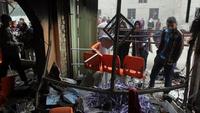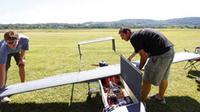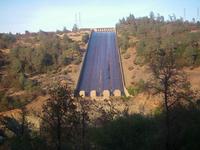-
Cybersecurity isn’t all about doom and gloom
Much is made in the press of the devastating effects that weak cybersecurity is having on the economy in the United Kingdom and globally. The threat is compounded by a significant skills shortage. The U.K. government thinks the problem is so severe that it has identified cybersecurity as a Tier 1 national security threat and invested 860 million pounds to defend the country’s digital shores. What all this means is that there is money to be made from cybersecurity and small businesses should not fear it but embrace it. The business opportunities are boundless in cybersecurity. One area that is promising in this sense is the move towards smart cities. As the infrastructure around us, such as traffic lights and utilities becomes more regularly controlled via computers, market opportunities emerge
-
-
Zapping bridges with electricity to test for corrosion
One out of nine of the nation’s bridges is structurally deficient and that more than 30 percent of bridges have exceeded their 50-year design life; the average age of the nation’s bridges is currently forty-two years. Motorists in the United States make more than 200 million trips across bridges rated structurally deficient or in need of significant maintenance and yearly inspection. Of the more than 17,000 bridges in New York, 12.5 percent are structurally deficient and 27 percent are considered functionally obsolete. One major culprit for bridges’ deterioration: corrosion of reinforcing steel. New testing method could replace expensive, time-consuming visual inspections.
-
-
New Jersey shore to face unprecedented flooding by mid-century
Geoscientists estimate that the New Jersey shore will likely experience a sea-level rise of about 1.5 feet by 2050 and of about 3.5 feet by 2100 — 11 to 15 inches higher than the average for sea-level rise globally over the century. That would mean, the scientists say, that by the middle of the century, the one-in-ten year flood level at Atlantic City would exceed any flood known there from the observational record, including Superstorm Sandy.
-
-
No need to worry about getting fried by gamma ray burst

If recent news that University of Alabama in Huntsville (UAH) researchers observed the largest gamma ray burst ever has you nervous about getting blasted into extinction by a massive burst from space, the UAH researchers have good news. The chances of Earth being fried by a burst are exceedingly rare.
-
-
New Silicon Valley focus on cybersecurity
The last time Silicon Valley focused on cybersecurity was in the 1990s. That focus saw the emergence of two giants: McAfee and Symantec. The two companies remain the most recognizable household names, thanks to their traditional firewall and anti-virus products. Now they find the arena which they thought was their own encroached from two sides. On one side there are tech giants like Hewlett-Packard and Cisco Systems, which see new revenue opportunity in cybersecurity. On the other side there is a rush of start-ups backed by large investments of venture capital.
-
-
Protecting cars from hackers
A U.S. senator has asked twenty automobile manufacturers how each plans to stave off wireless hacking attempts on the computer systems of the vehicle they manufacture, and also how they protect driver privacy. The questions by Senator Ed Markey (D-Massachusetts) indicate that he will demand that carmakers apply computer-industry security processes, including implementation of anti-virus software, incident logging, incident-response planning, software vulnerability patching, and third-party penetration testing — the last of which would stage real hacker attacks on mass-production vehicles.
-
-
Lawmakers: Old plastic gun law has not kept pace with technology
The U.S. House of Representativesvoted last Tuesday to renew the 25-year old Undetectable Firearms Actwhich prohibits firearms that can evade metal detectors and X-ray machines. Law enforcement agencies say that developments in 3D printing make the law insufficient, and lawmakers who proposed amending the Act say that the only way to make such guns detectable is to require that at least one component of the firing mechanism in a plastic gun contain enough metal to be detectable in a magnetometer — and that that component be undetachable. The NRA opposes these requirements, saying that they would infringe on the Second Amendment rights of citizens.
-
-
Cyber Gym in Israel trains cyber-defenders
A group of IT and infrastructure companies in Israel have teamed up to launch Cyber Gym.The facility, inaugurated this month by Israel Electric Corp. (IEC), will train participants to defend against cyber attacks.When Sivan Shalom, Israel’s Infrastructure and Energy Minister, was asked whether Israel was more concerned about a physical or a virtual attack, he said: “I think the future battle will be in cyberspace.”
-
-
One percent of Swedish criminals commit 63 percent of all violent crimes
The majority of all violent crime in Sweden is committed by a small number of people. Researchers have examined the case of all the people who were brought up on charges of violent crimes in Sweden between 1973 and 2004 – 2.5 million people in all. Of the 2.5 million individuals included in the study, 4 percent were convicted of at least one violent crime — 93,642 individuals in total. Of these convicted at least once, 26 percent were re-convicted three or more times, thus resulting in 1 percent of the population (23,342 individuals) accounting for 63 percent of all violent crime convictions during the study period.
-
-
Prolonged viewing of terrorist incident media coverage tied to acute stress

Stepping away from the television, computer screen or smartphone in the aftermath of terrorist attacks or mass shootings may be beneficial to your mental health. This is the takeaway from a new study showing that six or more daily hours of exposure to media coverage of the Boston Marathon bombings in the week afterward was linked to more acute stress than having been at or near the marathon. Acute stress symptoms increased with each additional hour of bombing-related media exposure via television, social media, videos, print, or radio.
-
-
Virginia Tech to get $2.6 million to test unmanned aircraft systems

The Commonwealth of Virginia announced it will award more than $2.6 million over three years in Federal Action Contingency Trust (FACT) funds to Virginia Tech to operate an unmanned aircraft systems test site in the state, officials from the governor’s office said. The test range is operated by the Mid-Atlantic Aviation Partnership, which is led by Virginia Tech and Rutgers University and represents an effort safely to develop unmanned aircraft systems. The University of Maryland has also agreed to partner with Virginia Tech and Rutgers on unmanned aircraft system integration.
-
-
Sea-level rise to drive flooding regardless of changes in hurricane activity
Clamor about whether climate change will cause increasingly destructive tropical storms may be overshadowing a more unrelenting threat to coastal property — sea-level rise — according to a team of researchers. Since 1970, more than 60 percent of all economic losses — about $400 billion — occurred in the North Atlantic, even though it is one of the least active basins for hurricanes.The scientists say accelerated sea-level rise certainly will increase the flooding and property damage triggered by tropical cyclones — commonly known as hurricanes in the Atlantic and Northern Pacific — but predicting where, how often, and how powerful these storms will be when they make landfall is full of uncertainty.
-
-
Feds, Calif. disagree on seismic safety of U.S. tallest dam

At 742 feet, Oroville Dam in Oroville, California is the tallest dam in the United States. It is 45-year old, and federal inspectors say it needs a comprehensive earthquake safety assessment. The California Department of Water Resources (DWR) insists that the dam, which holds 3.5 million acre-feet of water, is safe, and that such an assessment would be an “unjustified expense.” David Gutierrez, chief of California Division of Safety of Dams (DSD), says his agency will decide in January 2014 whether earthquake assessments will be made, but notes: “Oroville is not one that keeps me up at night from a seismic stability standpoint.”
-
-
Virtual wall to build invisible barrier for oil spills
The outer shell of a droplet of oil on a surface has a thin skin which allows it to hold its shape like a small dome; this shell is referred to as the liquid’s surface tension. Now, researchers have developed a technique to form a virtual wall for oily liquids that will help confine them to a certain area, aiding researchers who are studying these complex molecules. This development will have future implications in the guided delivery of oil and effective blockage of oil spreading.
-
-
Humans threaten wetlands' ability to overcome sea level rise
Left to themselves, coastal wetlands can resist rapid sea level rise. The reason: an intricate system of feedbacks which make wetlands remarkably good at building up soils to outpace sea level rise. Humans, however, could be sabotaging some of wetlands’ best defenses, according to results of a new study. The study examines two questions: when do wetlands reach their limit, and how are humans lowering that point?
-
More headlines
The long view
Are We Ready for a ‘DeepSeek for Bioweapons’?
Anthropic’s Claude 4 is a warning sign: AI that can help build bioweapons is coming, and could be widely available soon. Steven Adler writes that we need to be prepared for the consequences: “like a freely downloadable ‘DeepSeek for bioweapons,’ available across the internet, loadable to the computer of any amateur scientist who wishes to cause mass harm. With Anthropic’s Claude Opus 4 having finally triggered this level of safety risk, the clock is now ticking.”
A Brief History of Federal Funding for Basic Science
Biomedical science in the United States is at a crossroads. For 75 years, the federal government has partnered with academic institutions, fueling discoveries that have transformed medicine and saved lives. Recent moves by the Trump administration — including funding cuts and proposed changes to how research support is allocated — now threaten this legacy.
Bookshelf: Preserving the U.S. Technological Republic
The United States since its founding has always been a technological republic, one whose place in the world has been made possible and advanced by its capacity for innovation. But our present advantage cannot be taken for granted.
Autonomous Weapon Systems: No Human-in-the-Loop Required, and Other Myths Dispelled
“The United States has a strong policy on autonomy in weapon systems that simultaneously enables their development and deployment and ensures they could be used in an effective manner, meaning the systems work as intended, with the same minimal risk of accidents or errors that all weapon systems have,” Michael Horowitz writes.
Ukraine Drone Strikes on Russian Airbase Reveal Any Country Is Vulnerable to the Same Kind of Attack
Air defense systems are built on the assumption that threats come from above and from beyond national borders. But Ukraine’s coordinated drone strike on 1 June on five airbases deep inside Russian territory exposed what happens when states are attacked from below and from within. In low-level airspace, visibility drops, responsibility fragments, and detection tools lose their edge. Drones arrive unannounced, response times lag, coordination breaks.
Shots to the Dome—Why We Can’t Model US Missile Defense on Israel’s “Iron Dome”
Starting an arms race where the costs are stacked against you at a time when debt-to-GDP is approaching an all-time high seems reckless. All in all, the idea behind Golden Dome is still quite undercooked.
